ATF6 prevents DNA damage and cell death in colon cancer cells undergoing ER stress
- PMID: 35752616
- PMCID: PMC9233702
- DOI: 10.1038/s41420-022-01085-3
ATF6 prevents DNA damage and cell death in colon cancer cells undergoing ER stress
Abstract
Colon cancer represents one of the most common and aggressive cancers in its advanced state. Among the most innovative anti-cancer approaches, the manipulation of UPR is a promising one, effective also against cancers carrying dysfunctional p53. Interestingly, it is emerging that UPR cross-talks with DDR and that targeting the interplay between these two adaptive responses may be exploited to overcome the resistance to the single DDR- and UPR-targeting treatments. Previous studies have highlighted the role of IRE1 alpha and PERK UPR sensors on DDR, while the impact of ATF6 on this process remains under-investigated. This study shows for the first time that ATF6 sustains the expression level of BRCA-1 and protects colon cancer cells from the cytotoxic effect of ER stressors DPE and Thapsigargin. At molecular level, ATF6 activates mTOR to sustain the expression of HSP90, of which BRCA-1 is a client protein. Therefore, pharmacological or genetic inhibition of ATF6 promoted BRCA-1 degradation and increased DNA damage and cell death, particularly in combination with Adriamycin. All together this study suggests that targeting ATF6 may not only potentiate the cytotoxic effect of drugs triggering ER stress but may render colon cancer cells more sensitive to Adriamycin and possibly to other DNA damaging agents used to treat colon cancer.
© 2022. The Author(s).
Conflict of interest statement
The authors declare no competing interests.
Figures

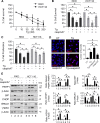
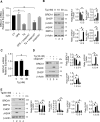

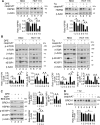
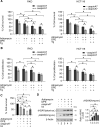
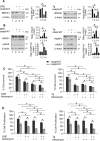

Similar articles
-
ATF6 supports lysosomal function in tumor cells to enable ER stress-activated macroautophagy and CMA: impact on mutant TP53 expression.Autophagy. 2024 Aug;20(8):1854-1867. doi: 10.1080/15548627.2024.2338577. Epub 2024 Apr 9. Autophagy. 2024. PMID: 38566314 Free PMC article.
-
Role of UPR Sensor Activation in Cell Death-Survival Decision of Colon Cancer Cells Stressed by DPE Treatment.Biomedicines. 2021 Sep 18;9(9):1262. doi: 10.3390/biomedicines9091262. Biomedicines. 2021. PMID: 34572447 Free PMC article.
-
Sustained IRE1 and ATF6 signaling is important for survival of melanoma cells undergoing ER stress.Cell Signal. 2014 Feb;26(2):287-94. doi: 10.1016/j.cellsig.2013.11.008. Epub 2013 Nov 12. Cell Signal. 2014. PMID: 24240056
-
The unfolded protein response as regulator of cancer stemness and differentiation: Mechanisms and implications for cancer therapy.Biochem Pharmacol. 2021 Oct;192:114737. doi: 10.1016/j.bcp.2021.114737. Epub 2021 Aug 16. Biochem Pharmacol. 2021. PMID: 34411568 Review.
-
The UPR in atherosclerosis.Semin Immunopathol. 2013 May;35(3):321-32. doi: 10.1007/s00281-013-0372-x. Epub 2013 Apr 4. Semin Immunopathol. 2013. PMID: 23553213 Free PMC article. Review.
Cited by
-
Hypoxia-Inducible Factor-Dependent and Independent Mechanisms Underlying Chemoresistance of Hypoxic Cancer Cells.Cancers (Basel). 2024 Apr 29;16(9):1729. doi: 10.3390/cancers16091729. Cancers (Basel). 2024. PMID: 38730681 Free PMC article. Review.
-
ATF6 Promotes Colorectal Cancer Growth and Stemness by Regulating the Wnt Pathway.Cancer Res Commun. 2024 Oct 1;4(10):2734-2755. doi: 10.1158/2767-9764.CRC-24-0268. Cancer Res Commun. 2024. PMID: 39324706 Free PMC article.
-
Activation of TRIM37 by ATF6 and degradation of ACSL4: inhibiting ferroptosis and propelling cervical cancer progression.Hereditas. 2025 Mar 29;162(1):47. doi: 10.1186/s41065-025-00404-9. Hereditas. 2025. PMID: 40158112 Free PMC article.
-
Reciprocal negative feedback regulation of ATF6α and PTEN promotes prostate cancer progression.Cell Mol Life Sci. 2023 Sep 16;80(10):292. doi: 10.1007/s00018-023-04940-3. Cell Mol Life Sci. 2023. PMID: 37715829 Free PMC article.
-
New insights into the unfolded protein response (UPR)-anterior gradient 2 (AGR2) pathway in the regulation of intestinal barrier function in weaned piglets.Anim Nutr. 2023 Sep 9;15:225-232. doi: 10.1016/j.aninu.2023.08.007. eCollection 2023 Dec. Anim Nutr. 2023. PMID: 38033605 Free PMC article. Review.
References
-
- Romeo MA, Gilardini Montani MS, Gaeta A, D’Orazi G, Faggioni A, Cirone M. HHV-6A infection dysregulates autophagy/UPR interplay increasing beta amyloid production and tau phosphorylation in astrocytoma cells as well as in primary neurons, possible molecular mechanisms linking viral infection to Alzheimer’s disease. Biochim Biophys Acta Mol Basis Dis. 2020;1866:165647. doi: 10.1016/j.bbadis.2019.165647. - DOI - PubMed
Grants and funding
- IG 2019 Id.23040/Associazione Italiana per la Ricerca sul Cancro (Italian Association for Cancer Research)
- 59/Istituto Pasteur-Fondazione Cenci Bolognetti (Pasteur Institute-Cenci Bolognetti Foundation)
- 2017K55HLC/Ministero dell'Istruzione, dell'Università e della Ricerca (Ministry of Education, University and Research)
LinkOut - more resources
Full Text Sources
Other Literature Sources
Research Materials
Miscellaneous

